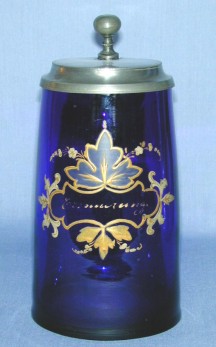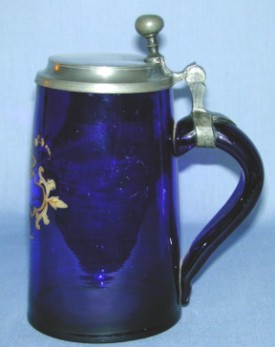by Jim Sauer
(Originally published in Prosit, March 1986)

|
Stein Collectors International, Inc. |
|
by Jim Sauer (Originally published in Prosit, March 1986) |
 |
 |
 |
| This half-liter cobalt blue glass stein dates to the mid-1800's. The beautiful, rich color of the glass was very popular, although less so for use in beer steins. The enameled and gilded decoration is typical of this period, as is the shape of the applied handle, being wide but somewhat flattened in cross section. | |
"Coloured glass was appreciated for its ornamental value and might have enjoyed much more success but for the fact that drinks in dark-coloured glasses take on a sinister appearance which is disturbing to Anglo-Saxons; they like to see what they are drinking. This was one of the disadvantages of china and metal drinking mugs, the makers of which fitted glass bottoms to them in the period under review to overcome these objections. Glassmakers knew this well enough and what they needed above all else was a good clear glass which could be sold to the masses at a price competitive with everything else." (Ref. 1)
In reviewing that statement, the English and the Germans shared a dislike for
dark-colored drinking vessels. The English inserted glass bottoms in drinking
mugs and considered the problem solved. This also points out the origin of the
glass bottom with the explanation being purely one of marketing, as dark-colored
mugs were difficult to sell. Also, several misconceptions can be corrected, as
the glass bottom had no connection with the ability of the drinker to detect
poison in his ale. Another myth has the Englishman looking through the glass
bottom of the mug while drinking to guard against being attacked. That and other
similar explanations can be discounted as untrue. However, German steins, with
the exception of cobalt-blue and dark glass, had light-colored interiors in the
early part of the nineteenth century. Faience, stoneware, opaline white glass
and also clear glass were available at that time. Porcelain steins with pure
white interiors became more common when production costs were lowered in the
latter part of the century. Villeroy & Boch at Mettlach also produced
stoneware steins with white glazed interiors, and continued that practice into
the twentieth century.
Another point for consideration would be the clarity or clearness of German
beer during the middle of the nineteenth century. In brewing beer, two different
methods of yeast fermentation were in use at that time. The long established
method of top-fermentation yielded good quality, but slightly clouded beer. The
fermented yeast rose to the surface of the brew and was skimmed off before the
lagering or aging stage.
Lower fermentation temperatures, improved water quality, longer lagering
periods, and newly developed strains of yeast brought about the successful
application of bottom-fermentation. In this process, the fermented yeast
remained at the bottom of the brew, and as a result, clarity and golden color
developed in the lagered beer.
Both golden color and clarity became strong selling points among competing
breweries and as a result Germans used more clear glass steins and clear
drinking glasses for their favorite beer.
Another fact comes to light: During the middle of the nineteenth century
glass houses developed means of mass producing clear drinking glasses at low
cost. Th
|
All rights reserved. |